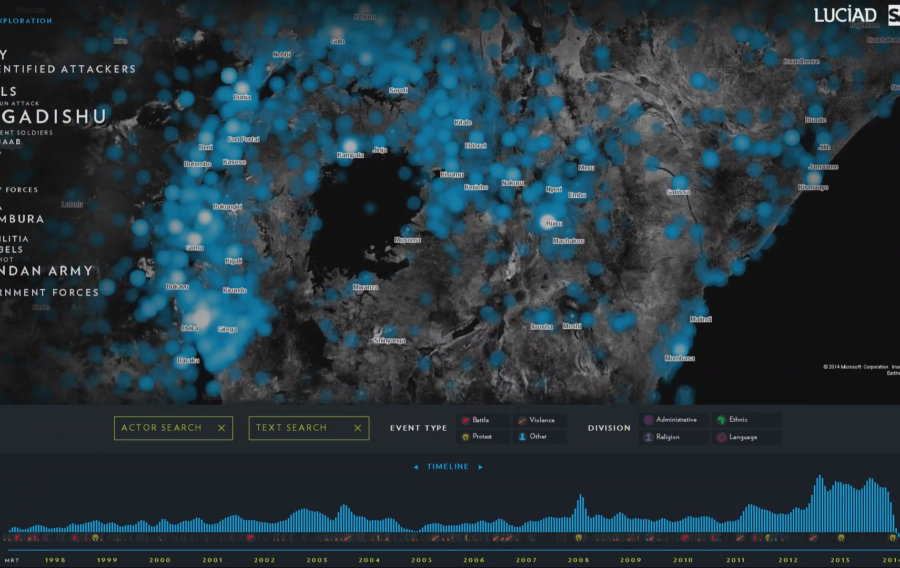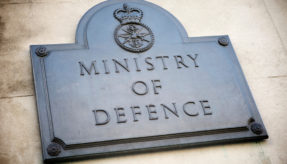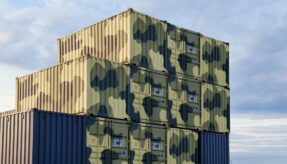
The term ‘land equipment’ is broad, extending to the equipment utilised to map and gain an educated awareness of foreign territory. Equipment applications are now required to work together to better inform the commander and personnel in the field. Defence writer Domhnall Macinnes caught up with Tony Wheeler, Sales Manager, Eastern Europe and Key UK Accounts at Luciad, to learn more about the integral role of Shared Situational Awareness.
Tony Wheeler, Sales Manager for Eastern Europe and Key UK Accounts at international high-tech software company Luciad, is a recently retired RAF Wing Commander and pilot with many years’ experience in the development, deployment and exploitation of C4ISTAR – Command, Control, Communications, Computers, Information/Intelligence, Surveillance, Targeting Acquisition and Reconnaissance – capabilities.
C4ISTAR solutions amalgamate the systems utilised by soldiers in the field to help them develop a better awareness of their environment and provide commanding officers with the information they need to inform their tactical decision-making.
Before leaving the RAF Mr Wheeler helped establish a Ministry of Defence battle lab, the C2BL, at Shrivenham. The core initial function of the team’s work was to help the MOD bring into service and best exploit C4ISTAR systems. Mr Wheeler became involved in particular with the Common Operating Picture (COP), which led to his involvement with Luciad. The MOD selected NATO’s Integrated Command & Control (ICC) software as its joint COP capability to provide the rich map-based information to support the commander’s decision making.
Luciad provides the key components to end solutions and at the heart of the ICC is LuciadMap, an Open Geospatial Consortium (OGC) and NATO standards-based capability which exploits C4ISTAR services.
During Mr Wheeler’s time at the C2 Battle Lab, he managed the delivery of the UK modification to the ICC system to meet UK COP needs; the system was then deployed in Afghanistan. The team also worked on other systems.

Mr Wheeler explained: “We worked on the Tactical Ground Reporting system (TIGR), a US Defense Advanced Research Projects Agency (DARPA) system. It was designed for the Army and for use by Army personnel on patrol, initially in Iraq and subsequently in Afghanistan. At the C2BL we suggested changes to the TIGR system and these were incorporated into TIGR for UK and US forces, and improved the exchange of key information between systems.
“British Army personnel developed overlays and recorded information on TIGR, ICC and other C4ISTAR system and these were exchanged with the Joint Automated Deep Operations Coordination System (JADOCS). The systems had to present the same (common) information layers to ensure Shared Situational Awareness and the C2BL developed Standard Operating Procedures (SOPs) to enable that critical exchange of information. Following my time at the Battle Lab I was in Afghanistan and coincidentally got to deploy the improved ICC capability across theatre.”
The TIGR system was a unique capability that provided land forces, at the tactical level, with a situational awareness of their battlespace as well as an understanding of both the current intelligence situation and its history. Army land patrols – small groups of individuals going out into hostile terrain by foot or vehicle – used the TIGR system to gain battlespace awareness, plan their patrols and input reports after a patrol.
Mr Wheeler discussed his primary task at the C2 Battle Lab of enabling information to be shared across different systems.
He said: “In Afghanistan the tactical networks were joined to the operational higher-level network named the Afghan Mission Network (AMN). The AMN had many C4ISTAR systems, including ICC and JADOCS, which the Battle Lab modified some years earlier.
“The information across the three systems had previously not been able to be shared on a common network but our work at the C2BL helped change that. Some of the information available on the JADOCS and ICC systems at the higher command level became shareable with the lower tactical level in TIGR, and vice versa.”
He continued: “The C2 Battle Lab was at the heart of work to improve interoperability between systems. This meant we were involved with the systems developers to change the systems for the better, but it also meant we had to describe improved ways of working so our people could better use what they had at that time: we created the SOPs to do just that.”
Interoperability is integral to situational awareness in the field. Shared Situational Awareness (SSA) is the sharing of common intelligence, utilising common information from different applications, databases and track feeds.
Mr Wheeler expanded: “Interoperability between applications enabled an ability to share the same information layers on the operating picture. Having the same mapping and imagery background at the back of a Common Operating Picture is fundamentally key. During Operation Herrick – the codename for all British military action in Afghanistan executed between 2002 and 2014 – applications that were not interoperable caused a great many problems; for many we were unable to use the same delivery methods to put even the mapping and imagery in the background.
“What we have always aspired to is the use of common services. Increasingly on networks such as the Afghan Mission Network and our future Federated Mission Network (FMN) – which NATO aspires to – the object is to deliver common services. What that means is that all systems in the future would use, for instance, a common Web Map Service (WMS) as the source of their mapping and their imagery.”
An example of this lack of interoperability applied to civilian life would be Google and Bing. Google Maps and Google Earth both use the same imagery. Bing, however, uses its own, so the two companies use separate mapping; a bridge seen on one system may not be present on another, and that could be significant to the military commander.
In a military environment, this lack of a common reference map would not be acceptable. GIS servers delivered by companies such as Luciad can deliver standard Web Map Services so that many applications can exploit the same mapping background.
Other layers of the COP can be shared through other information exchange standards such as the NATO Friendly Force Information (NFFI) and Link 16 standards that can share track-based information that represents land tracks: the vehicles, the men on foot carrying beacons, the headquarter entities, or the aircraft in that airspace.
To deliver a Common Operating Picture it is essential that end users gain the very same situational awareness regardless of the system used – this Shared Situational Awareness is key. Today’s focus and reliance upon common services is by design, and is based upon agreed OGC and NATO standards. Luciad is at the fore with such standards, both in the ability of its components to consume those standards, and in the company’s work to evolve these standards as a technical member.
Mr Wheeler concluded with some advice for component-based SMEs, who supply a product to a larger entity which then builds the complete solution. His advice also extended to end solution based companies.
He commented: “For a component-based SME like Luciad, the main way to the defence market is by convincing a large entity, an integrator, that your components are of superior quality and having them integrated into an end solution.
“If you’re an SME that has components to deliver, like Luciad, that’s the only way to market because the Ministry of Defence doesn’t buy the components. Normally they buy the solutions from one of the major defence industry companies, whether it’s BAE Systems, Lockheed Martin or General Dynamics. So alignment with the major companies is a key thing.
“A way of achieving entry into the market if you do deliver end solutions is to provide interoperable capability based upon the standards discussed above. That would mean that your system will quite simply plug and play into the increasingly standards-based architecture utilised by the MOD and by NATO.”
If you would like to join our community and read more articles like this then please click here
C4ISTAR land equipment Luciad MOD Shared Situational Awareness UK







